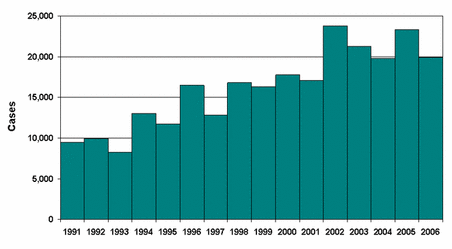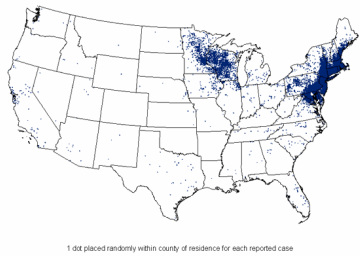Origin

Lyme Disease in the United States from 1991 to 2006.
Borrelia burgdorferi is predominant in North America, and is also found to exist in Europe and many temperate parts of the Northern Hemisphere. In North America, the bacteria is common in northeastern, midwestern and western U.S. The highest incidences of the bacteria take place in the Northeast, from Massachusetts to Maryland, and the North-central states, mainly Wisconsin and Minnesota. According to the CDC (Centers for Disease Control and Prevention), there were 19,931 new cases reported of Lyme disease in 2006. From 1996 and 2001, the average number of cases was around 17,000 per year. In 2002, the number increased to over 20,000 new cases per year. In addition to the spread of Lyme disease, the rise in the number of cases is also accredited to increased surveillance and increased reporting.

Reported Cases of Lyme Disease in the United States in 2006.
In the United States, ten states have consistently reported an incidence of Lyme disease higher than the national average. These ten states include Connecticut, Delaware, Maryland, Massachusetts, Minnesota, New Jersey, New York, Pennsylvania, Rhode Island and Wisconsin. According to the CDC, 64,382 Lyme disease cases were reported during 2003-2005. Most of these cases, totaling 59,770 (93%), were reported from these ten states. The average in these ten states was 31.6 cases for every 100,000 persons for the year 2005. In 2006, a similar outcome emerged.
In Northern Europe, 19% of patients or at-risk subjects in Sweden, test positive for antibodies to Borrelia burgdorferi, while in in Estonia, 2.7% do. In Central Europe, 28% of patients or at-risk subjects in The Netherlands do so, 26% in Switzerland do so and 15% in Poland do so. The range of antibodies to Borrelia burgdorferi in blood donors or control subjects is 15% in Ireland, 7.7% in Austria and 5.5% in Germany. In Southern Europe, the numbers range from 43% in Croatia to 1.1% in Greece. In Italy, the number of patients or at-risk subject that test positive for antibodies to Borrelia burgdorferi varies. In Northern Italy, the numbers go from 3.2% in Lombardia to 22.3% in Friuli. In Central Italy, the lowest number is 0.2% in Emilia (Parma) while the highest is 18.3% in Toscana. The range of antibodies to Borrelia burgdorferi in blood donors or control subjects is the lowest in Lazio at 1.5%, while the highest in Sicilia at 10.9%. According to the U.S. National Library of Medicine and National Institutes of Health, infection diffusion by Borrelia burgdorferi is increasing while the statistical evaluations, comparisons and acceptable conclusions continuously present a problem.
In Northern Europe, 19% of patients or at-risk subjects in Sweden, test positive for antibodies to Borrelia burgdorferi, while in in Estonia, 2.7% do. In Central Europe, 28% of patients or at-risk subjects in The Netherlands do so, 26% in Switzerland do so and 15% in Poland do so. The range of antibodies to Borrelia burgdorferi in blood donors or control subjects is 15% in Ireland, 7.7% in Austria and 5.5% in Germany. In Southern Europe, the numbers range from 43% in Croatia to 1.1% in Greece. In Italy, the number of patients or at-risk subject that test positive for antibodies to Borrelia burgdorferi varies. In Northern Italy, the numbers go from 3.2% in Lombardia to 22.3% in Friuli. In Central Italy, the lowest number is 0.2% in Emilia (Parma) while the highest is 18.3% in Toscana. The range of antibodies to Borrelia burgdorferi in blood donors or control subjects is the lowest in Lazio at 1.5%, while the highest in Sicilia at 10.9%. According to the U.S. National Library of Medicine and National Institutes of Health, infection diffusion by Borrelia burgdorferi is increasing while the statistical evaluations, comparisons and acceptable conclusions continuously present a problem.
